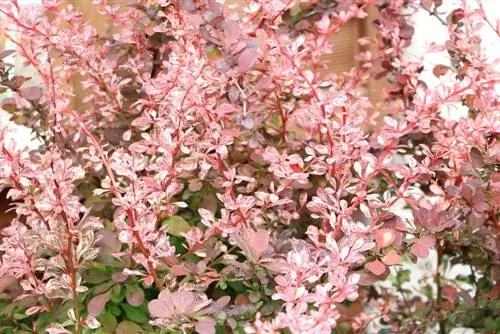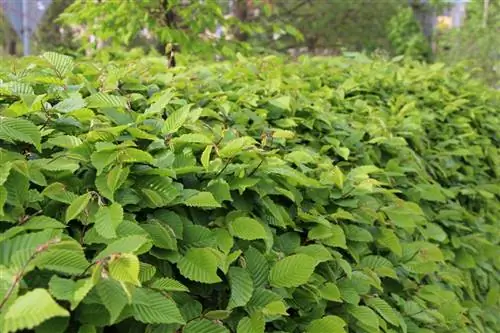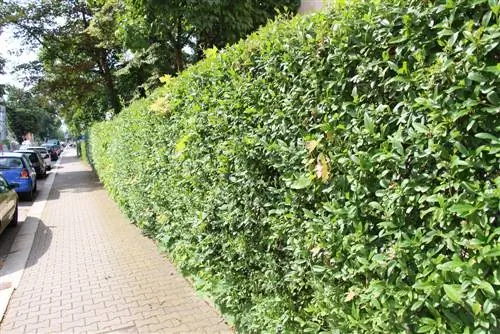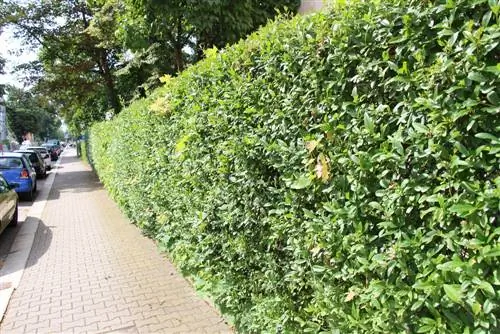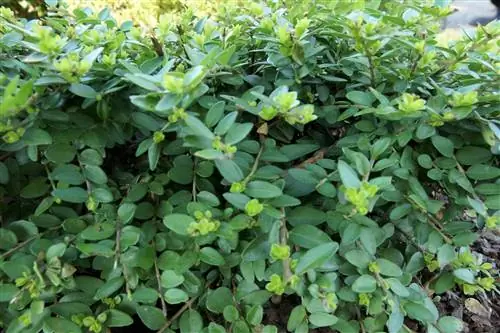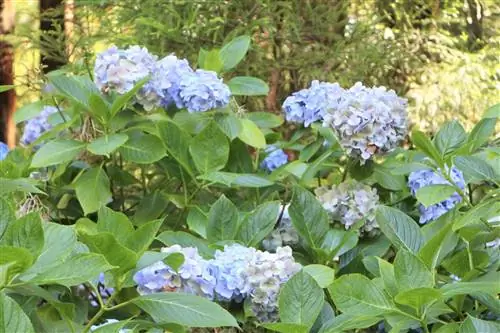- Author admin [email protected].
- Public 2023-12-17 03:39.
- Last modified 2025-01-24 12:45.
The morning chirping of the birds has long since been replaced by the noise of the street. Their habitats are becoming increasingly smaller, which has far-reaching consequences. Birds are an important part of ecological balance and decimate various pest insects, of which there are more than enough in urban areas. With a bird hedge, gardeners not only offer the animals a habitat, they also benefit from an easy-care privacy screen.
Planning a hedge
A hedge for birds cannot simply be planted bush by bush, especially because more than just one type of tree is usually used. Different plants can also provide a habitat for many different birds. However, the different shrubs also have their own needs. Some like it more sunny, others grow much better on shady north sides. A planting plan should be drawn up so that the different needs are taken into account.
This plan not only serves to distribute the perennials according to their location requirements, but also to take different growth forms into account. Perennials such as hazel or elder grow very quickly, while cornelian cherries develop much more slowly. The growth can be relevant to how quickly a hedge provides privacy, but also how intensive it is in terms of care or pruning.
A planting plan is also important when it comes to creating an opaque hedge. This means that the different bushes sometimes have to be planted in a staggered manner. Compared to other hedges, the bird hedge requires significantly more space, which is also outlined in the plan. The ideal width for the bird hedge is three meters.
Tip:
It is enough if you plan the hedge for a certain length. The scheme is then simply repeated and combining selected perennials in sections ensures a staggered display of flowers and fruit ripening.
Plant selection
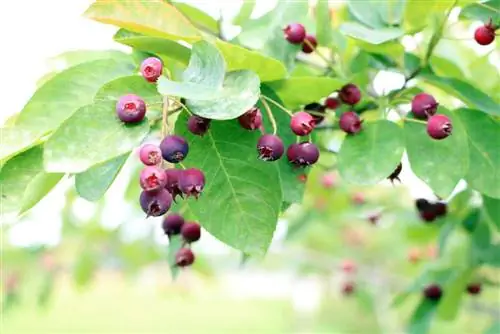
When selecting plants, it is important to take the space required into account. Tall perennials require an average of one meter of space, while shorter trees need around 70 cm. The bird protection hedge is characterized by the fact that it not only provides a habitat for birds, but is also a source of food for numerous other animals such as squirrels and various reptiles and insects. If you want to create a bird hedge, you should preferably use local trees. There are numerous wild shrubs to choose from, which also have visual appeal through different leaf colors and shapes.
These shrubs are suitable for a bird protection hedge:
Aronia (Aronia melanocarpa)
White flowers with black ripening fruits. Suitable for all birds.
Barberry (Berberis vulgaris)
Yellowish flowers with reddish fruits. Beautiful foliage color in reddish nuances. Suitable for all small birds, especially as protection and for nesting.
Rock Pear (Amelanchier ovalis)
White almost star-shaped flowers and bluish fruits. Suitable for all birds and particularly popular with blackbirds, thrushes, finches and starlings.
Dog rose (Rosa canina)
White to soft pink flowers and red rose hips. Suitable for all birds and an important source of vitamins for them in winter.
Cornelian cherry (Cornus mas)
Yellowish flowers in early spring with red fruits in autumn. Beautiful autumn color of the foliage. Suitable for all birds and an important source of vitamins.
Pfaffenhütchen (Euonymus europaeus)
Inconspicuous greenish flowers with striking orange-red fruits that look similar to a priest's headdress. Suitable for robins.
Blackthorn (Prunus spinosa)
Lush white flowers in spring and dark fruits in autumn. Suitable for all birds and particularly popular with wrens and red-backed shrikes.
Black Elderberry (Sambucus nigra)
White flowers with black fruits. Suitable for around 60 different species of small birds.
Rowberry (Sorbus aucuparia)
Yellowish flowers with orange to red fruits in autumn. Suitable for all birds.
Hawthorn (Crategus monogyna)
White flowers in spring with red ripening fruits. Suitable for blackbirds, thrushes and grosbeaks.
Aronia is the only exception to the native trees because it originally comes from North America. However, the fruits of Aronia are particularly popular with birds, which is why it can also be included in the lists of woody plants. There are numerous other plants that are suitable for a hedge for birds.
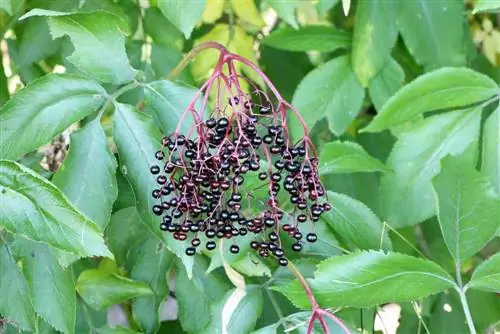
It is important when buying shrubs that the perennials are adapted to the regional climate. When creating a bird hedge, you should therefore preferably look at local tree nurseries and perennial nurseries. They can usually provide shrubs adapted to regional conditions.
Benefits for insects
The hedge for birds is also very useful for insects because it also offers them a source of food. Because of the insects that are attracted, especially when the bushes are in bloom, the birds have tasty insects to eat. Especially when the young have hatched, they need significantly more insects. In spring, many shrubs are an important source of nectar because they bloom before the cultivated plants. These include, for example, the cornelian cherry, which blooms before all other wild shrubs.
Tip:
With the right selection of shrubs, there is a varied range of flowers for insects from early spring to early summer. Diversity in shrubs also provides habitat for different bird species.
Soil preparation
After selecting the shrubs and planning the hedge, the soil must be prepared for the plants. To do this, it should be loosened deeply over the entire area. As a rule, a hedge for birds is planted in at least two rows. For each additional row, at least another half meter to meter of width must be added. After the soil has been loosened, humus and long-term fertilizer, for example in the form of horn shavings, can be incorporated into the soil. If the soil is heavily compacted or clayey and there is a risk of waterlogging, additional sand can be added.
Planting
For the actual planting, a planting hole is dug at least twice the ball size of the bush. If the soil is dense or clayey, you should dig a little deeper and create a drainage system made of sand and gravel so that there is no waterlogging.
The perennials may only be buried minimally beyond their previous depth. Otherwise, the perennials may form underground runners. This would allow the bushes to develop more lushly, but would also require more space, which is usually not taken into account. Before the perennials are put into the ground, they are checked to see if there are any kinked or broken roots. These will be cut back if necessary. If the perennials are in a bale cloth, it simply needs to be folded back. Bale cloths can be buried as they rot.
Tip:
The ideal planting time is March or October. During this time I can expect more moisture from precipitation and the temperatures will encourage the perennials to grow well.
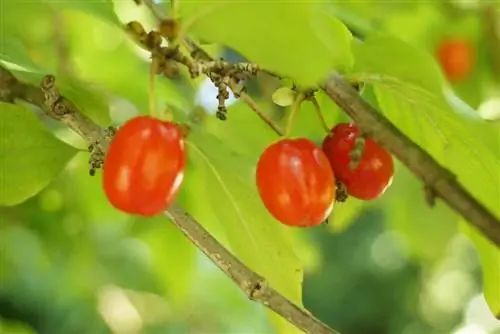
After the perennials are in the soil, they are carefully pressed down. The bushes are then watered well, but without causing waterlogging. In the first four weeks, the hedge should be watered regularly until the perennials are well rooted. A watering channel around a fresh planting ensures that the water does not run away.
Care
The advantage of a bird protection hedge is that it is significantly less expensive to maintain. It just needs to be trimmed occasionally. Some shrubs don't even need to be pruned every year due to their weak growth.
Compared to other hedges, wild fruits can also be cut into old wood without any risk. This is actually an advantage for wildlife, because the hedge should grow lushly, but not be so dense that the birds can no longer get in. Therefore, older branches should be removed every few years to thin out the hedge again.
Tip:
Many wild fruits can be propagated through cuttings, which means the hedge can be expanded without having to buy more. The cuttings can be taken directly when trimming the hedge.
Possible problems
If you want to create a hedge for birds, you may be faced with some problems that other hedges don't have. This primarily includes leaves. Hardly any native wild trees are evergreen. Therefore, a lot of leaves accumulate in autumn. As a rule, the leaves do not need to be removed. On the contrary, it is enough if it is raked to the hedge, which will compost it on the spot and bring nutrients back into the soil.
More problems caused by the wild fruit hedge:
- Contamination from fruits
- Perennials do not develop well due to too dense planting
- Perennials do not produce flowers and fruits due to the wrong location
- Birds dirty the terrace and paths when they eat the fruit
Occasionally there are space problems, but this is only the case if no planting plan has been drawn up beforehand that takes the needs of the perennials into account. Pest infestations or diseases rarely occur in wild fruit hedges. If there is a pest infestation, such as aphids on elderberries, beneficial insects take care of this problem. Since the fruit is left to the birds, the quality of the fruit from the hedge is also irrelevant.

